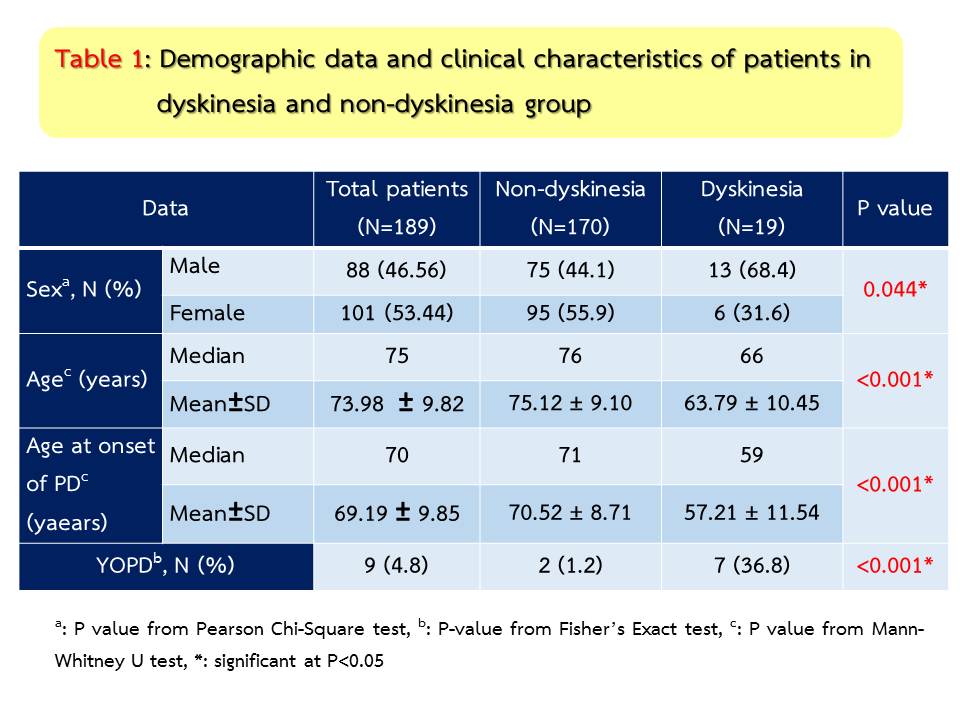Session Information
Date: Monday, October 8, 2018
Session Title: Parkinson's Disease: Pathophysiology
Session Time: 1:15pm-2:45pm
Location: Hall 3FG
Objective: To determine the prevalence and risk factors associated with peak-dose dyskinesia in Thai patients with Parkinson’s disease.
Background: Dyskinesias are involuntary movement that interfere normal daily activities of patients, the most common pattern of dyskinesia from anti-parkinson’s therapy is peak-dose dyskinesia [1, 2]. Several studies reported the prevalence of dyskinesia between 52-78% after 10 years of therapy and factors associated with dyskinesia were disease duration, Hoehn–Yahr stage and dosage of levodopa [2]. However, prevalence and risk factors of dyskinesia in Thai patients with PD has not been determined.
Methods: This study was retrospective study, performed during May and June 2017 at HRH Princess Maha Chakri Sirindhorn Medical Center (MSMC). We reviewed medical records of all PD patients at MSMC. Patients who treated with anti-parkinson’s medications and had followed up at least 6 month were eligible for participation. Patients who were not able to find their exact time of first diagnosis data were excluded. We recorded demographic data and total levodopa equivalent daily doses were calculated based on Tomlinson CL et al. [3]. We compared the variables between dyskinesia and non-dyskinesia group using independent T-test or Mann-Whitney U test and Chi-square analysis.Multivariate logistic regression analysis was performed to determine factors which were related to dyskinesia. All data were significance in level of 0.05.
Results: There were 189 PD patients included to this study (Figure 1). The prevalence of dyskinesia were 10.1% (95%CI 5.7%-14.4%).Demographic and clinical characteristics of 170 non-dyskinesia PD patients and 19 dyskinesia PD patients were shown in Table 1. We found that patients with dyskinesia were significantly with male (p= 0.044), older (p<0.001), early age at onset of PD or YOPD (p<0.001), received entacapone (p<0.001), higher levodopa daily dose (p=0.005), levodopa more than 500 mg/day (p=0.008), and higher total LEDD (p<0.001) than those patients without dyskinesia (Table 1 and 2).Independent factors related to dyskinesia which analyzed by multivariate logistic regression analysis were age at onset of PD [OR=0.86, 95%CI 0.81-0.92, P<0.001] and levodopa dose more than 500 mg/day [OR=7.75, 95%CI 1.76-34.10, P=0.007]. (Table 3)
Conclusions: Dyskinesia is affecting 1 in 10 of our Thai PD patients. The associated risk factors are early age onset of PD and high dose of levodopa. Therefore, PD patients who having these significant factors should be monitored for the presence of dyskinesia.
References: 1. Amanzio M, Monteverdi S, Giordano A, Soliveri P, Filippi P, Geminiani G. Impaired awareness of movement disorders in Parkinson’s disease. Brain Cogn. 2010;72(3):337-46. 2. Nicoletti A., Mostile G., Nicoletti G., Arabia G., Iliceto G., Lamberti P. et al. phenotype and risk of levodopa-induced dyskinesia in Parkinson’s disease. J Neurol 2016; 263:888–94. 3.Tomlinson CL, Stowe R, Patel S, Rick C, Gray R, Clarke CE. Systematic Review of levodopa Dose Equivalency Reporting in Parkinson’s Disease. Mov Disord. 2010;25,(15): 2649-85. 4. Olanow CW, Kieburtz K, Rascol O, Poewe W, Schapira AH, Emre M, et al. Stalevo Reduction in Dyskinesia Evaluation in Parkinson’s Disease (STRIDE-PD) Investigators. Factors predictive of the development of Levodopa-induced dyskinesia and wearing-off in Parkinson’s disease. Mov Disord. 2013;28(8):1064-71. 5. Hauser RA, Dermott MP, Messing S. Factors associated with the development of motor fluctuations and dyskinesias in Parkinson disease. Arch Neurol . 2006;63(12):1756-60.
To cite this abstract in AMA style:
S. Klanbut, C. Luangsinsiri, N. Piyaparneekul, C. Khongbut, K. Methawasin. Prevalence and risk factor of peak-dose dyskinesia in Thai patients with Parkinson’s disease [abstract]. Mov Disord. 2018; 33 (suppl 2). https://www.mdsabstracts.org/abstract/prevalence-and-risk-factor-of-peak-dose-dyskinesia-in-thai-patients-with-parkinsons-disease/. Accessed December 9, 2025.« Back to 2018 International Congress
MDS Abstracts - https://www.mdsabstracts.org/abstract/prevalence-and-risk-factor-of-peak-dose-dyskinesia-in-thai-patients-with-parkinsons-disease/

